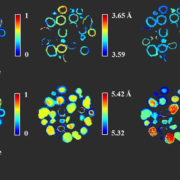Work on 5D chemical imaging of an operating catalyst published
A 5D diffraction imaging experiment (with 3D spatial, 1D time/imposed operating conditions and 1D scattering signal) was performed with a Ni-Pd/CeO2-ZrO2/Al2O3 catalyst. The catalyst was investigated during both activation and partial oxidation of methane (POX). The spatio-temporal resolved diffraction data allowed us to obtain unprecedented insight into the behaviour and fate of the various metal and metal oxide species and how this is affected by the heterogeneity across catalyst particles. We show firstly, how Pd promotion although facilitating Ni reduction, over time leads to formation of unstable Ni-Pd metallic alloy, rendering the impact of Pd beyond the initial reduction less important. Furthermore, in the core of the particles, where the metallic Ni is primarily supported on Al2O3, poor resistance towards coke deposition was observed. We identified that this preceded via the formation of an active yet metastable interstitial solid solution of Ni-C and led to the exclusive formation of graphitic carbon, the only polymorph of coke observed. In contrast, at the outermost part of the catalyst particle, where Ni is predominantly supported on CeO2-ZrO2, the graphite formation was mitigated but sintering of Ni crystallites was more severe.
Read the full article at https://doi.org/10.1039/D1TA01464A.

